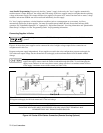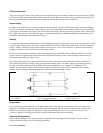
User Connections
80
1 = Voltage programming source 0 to -5 V
2 = Current programming source 0 to +5 V
3 = Current programming source 0 to -5 V
4 = Current programming source floating 0 to 5 V
* Maximum potential between -IP and ↓P or between +IP and ↓P is ±15 V
Figure 4-5g. Series 668xA Analog Programming Connections
Programming
Note from Figure 4-1 that you have three options for programming the current. You can use a voltage source that is positive,
negative, or floating with respect to Common P. Do not exceed +15 V with respect to Common P.
Make certain that the common connection for your voltage programming source is isolated from the load.
Failure to do this may cause damage to the power supply.
The effect of the analog programming source is always summed with the values programmed over the GPIB or from the front
panel. The voltage source can act alone only if you set the other program sources to zero. Keep the total programmed setting of
the supply (the analog input summed with the GPIB or front panel settings) at or under the output ratings specified in Table 1-3a.
Exceeding the output ratings will not damage the supply, but it may not be able to regulate its output the higher levels. If this
happens, the Unr annunciator will light to warn you that the output is unregulated.
Controller Connections
Figure 4-6 shows two basic ways of connecting your power supply to a controller. They are "linked" and "stand-alone
configurations.
Stand-Alone Connections
See Figure 4-6A. Each stand-alone power supply has its own GPIB bus address. Stand-alone power supplies may be
connected to the bus in series configuration, star configuration, or a combination of the two. You may connect from
1 to 15 stand-alone power supplies to a controller GPIB interface.
Linked Connections
See Figure 4-6B. Up to 16 power supplies may be used at a single GPIB primary bus address by making linked
connections. (You cannot use linked connections if you intend to program power supplies with the Compatibility
Language - see the power supply “Programming Guide".)


















